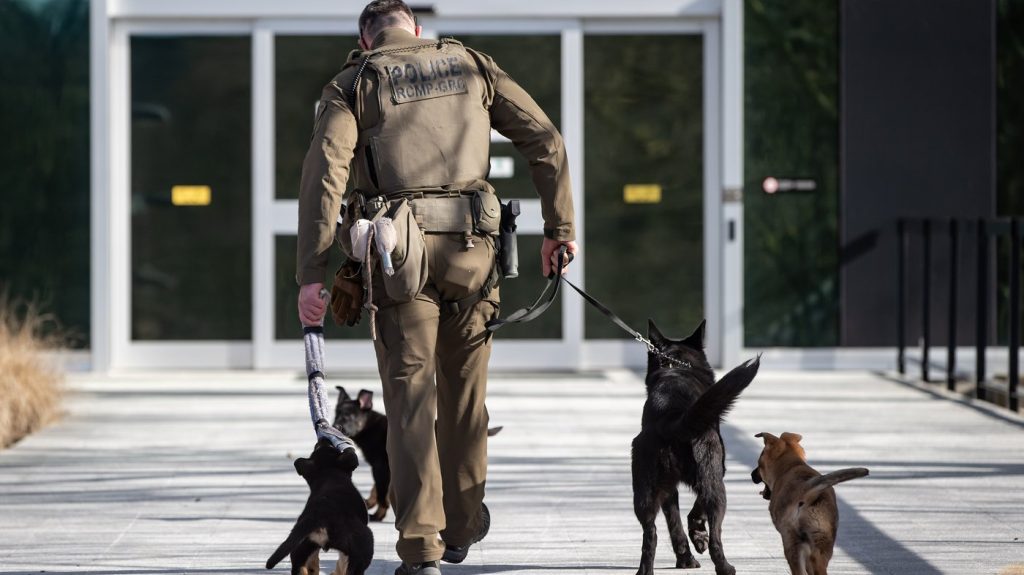Problems with RCMP police dog program pose ‘health and wellness risks’: evaluation

Posted Dec 14, 2024 07:00:09 AM.
Last Updated Dec 14, 2024 10:50:07 AM.
OTTAWA — The RCMP’s police dog training centre has been plagued by staffing shortages, low morale and rundown facilities that pose health risks to officers and canines, an internal review says.
The evaluation of RCMP police dog services reveals numerous challenges for the program that supplies and trains four-legged helpers to protect VIPs, support emergency teams, and sniff out suspects and illicit drugs.
Reviewers looked at the governance and delivery of the force’s police dog services between 2018-19 and 2023-24, drawing on interviews and a survey undertaken in RCMP divisions and the training centre.
The evaluation found the dog services, which date to 1935 with the RCMP’s purchase of its first puppy, were valued by front-line members.
The RCMP has come to rely on its own breeding program due to prices and demand for German Shepherds.
Imprinting begins when a puppy passes a seven-week test and is paired with an RCMP member who aspires to be a handler and has completed a special course.
Training, which begins when a dog is between one and two years of age, aims to make the handler and animal an efficient team.
The breeding program is essential to the service, and provides a sufficient number of dogs to support the program, the reviewers found.
However, there were a number of challenges, including the lengthy imprinting process, a lack of resources to support imprinters and provision of training, the limited frequency and types of courses available, and poor infrastructure at the training centre.
During the period under review, only 17 of 26 positions were staffed at the training centre. Some employees said that even with a full complement of staff, more positions are needed to meet the demands of front-line policing.
In 2005, there were seven trainers at the centre and 125 dog teams in the field. In 2022, there were eight trainers at the centre and 157 teams working.
Some interviewees reported that there were not enough dog handlers to cover holidays, time off, training or absences due to illness. Dog handlers said they often took their equipment and dog with them on vacation so they could be available when needed.
“The work environment and infrastructure within (the training centre) pose significant health and wellness risks to employees and dogs,” the evaluation says.
It notes an audit conducted in early 2023 found the training centre was deficient in 11 of 13 psychological factors for a healthy workplace.
The evaluation seemed to confirm the findings, with interviewees saying they had little control and felt overworked. They also cited poor communication and identified management of the program “as a contributing factor to the low morale.”
Many handlers refused to house their police service dogs at the Police Dog Service Training Centre in Alberta due to kennels that caused great stress and posed potential health hazards.
Among the stressors were a lack of natural light, inability for the dogs to go outside, and loud noise during feeding and cleaning times. Possible hazards included choking from chewing on peeling flooring, lead poisoning from eating paint flakes, and respiratory disease due to poor ventilation.
Dog service teams also faced health risks in the field.
Service members attend high-risk calls, many times with emergency response teams, but often lack safety equipment including night vision goggles, ballistic helmets and protective masks, the evaluation says.
In addition, handlers said they worked a lot of overtime and were often on call.
“Interviewees reported that the job takes a toll on their physical and mental health, with a few suggesting that they should have access to psychologists that understand the stresses.”
The evaluators made several recommendations to address the health and safety concerns as well as the program’s policy, reporting structure, sustainability and training.
An RCMP management response included with the evaluation outlines numerous planned actions over the coming year and beyond to make improvements.
This report by The Canadian Press was first published Dec. 14, 2024.
Jim Bronskill, The Canadian Press








